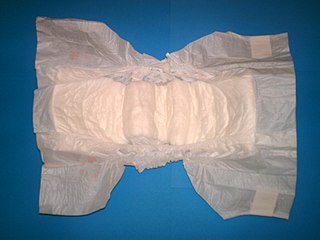
A diaper /ˈdaɪpə(r)/ or a nappy is a type of underwear that allows the wearer to urinate or defecate without using a toilet, by absorbing or containing waste products to prevent soiling of outer clothing or the external environment. When diapers become wet or soiled, they require changing, generally by a second person such as a parent or caregiver. Failure to change a diaper on a sufficiently regular basis can result in skin problems around the area covered by the diaper.
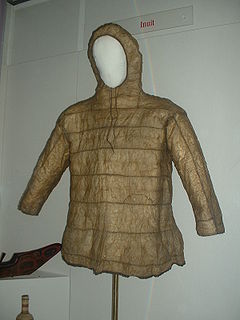
A parka or anorak is a type of coat with a hood, often lined with fur or faux fur. The Caribou Inuit invented this kind of garment, originally made from caribou or seal skin, for hunting and kayaking in the frigid Arctic. Some Inuit anoraks require regular coating with fish oil to retain their water resistance.
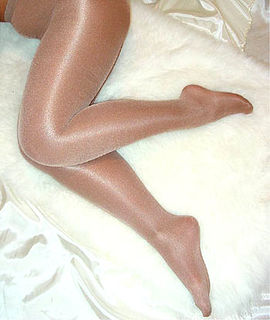
Pantyhose, called sheer tights, or tights in the United Kingdom and a few other countries, are close-fitting legwear covering the wearer's body from the waist to the toes. Mostly considered to be a garment for women and girls, pantyhose first appeared on store shelves in 1959 as a convenient alternative to stockings and/or control panties.
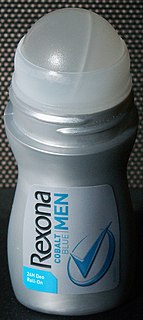
A deodorant is a substance applied to the body to prevent or mask body odor due to bacterial breakdown of perspiration in the armpits, groin, and feet, and in some cases vaginal secretions. A subclass of deodorants, called antiperspirants, prevents sweating itself, typically by blocking sweat glands. Antiperspirants are used on a wider range of body parts, at any place where sweat would be inconvenient or unsafe, since unwanted sweating can interfere with comfort, vision, and grip. Other types of deodorant allow sweating but prevent bacterial action on sweat, since human sweat only has a noticeable smell when it is decomposed by bacteria.
Body odor is present in all animals, including humans, and its intensity can be influenced by many factors. Body odor has a strong genetic basis, but can also be strongly influenced by various diseases and physiological conditions. Though body odor has played an important role in early humankind, it is generally considered to be an unpleasant odor amongst many human cultures.
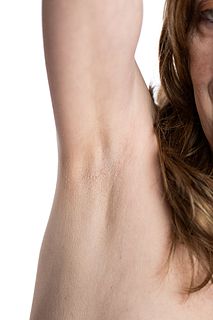
The axilla is the area on the human body directly under the joint where the arm connects to the shoulder. It also contains many sweat glands.

A sanitary napkin, sanitary towel, sanitary pad, menstrual pad, or pad is an absorbent item worn by menstruators in the underwear when menstruating, bleeding after giving birth, recovering from gynecologic surgery, experiencing a miscarriage or abortion, or in any other situation where it is necessary to absorb a flow of blood from the vagina. A menstrual pad is a type of menstrual hygiene product that is worn externally, unlike tampons and menstrual cups, which are worn inside the vagina. Pads are generally changed by being stripped off the pants and panties, taking out the old pad, sticking the new one on the inside of the panties and pulling them back on. Pads are recommended to be changed every 3-4 hours to avoid certain bacteria that can fester in blood, this time also may differ depending on the kind you wear, your flow, and the time you are wearing it.

A bathrobe, also known as a housecoat or a dressing gown, is a robe, a loose-fitting outer garment, worn by people. Bathrobes may sometimes be worn after a body wash or around a pool.

Sweat glands, also known as sudoriferous or sudoriparous glands, from Latin sudor 'sweat', are small tubular structures of the skin that produce sweat. Sweat glands are a type of exocrine gland, which are glands that produce and secrete substances onto an epithelial surface by way of a duct. There are two main types of sweat glands that differ in their structure, function, secretory product, mechanism of excretion, anatomic distribution, and distribution across species:

Intertrigo refers to a type of inflammatory rash (dermatitis) of the superficial skin that occurs within a person's body folds. These areas are more susceptible to irritation and subsequent infection due to factors that promote skin breakdown such as moisture, friction, and exposure to bodily secretions such as sweat, urine, or feces. Areas of the body which are more likely to be affected by intertrigo include the inframammary fold, intergluteal cleft, armpits, and spaces between the fingers or toes. Skin affected by intertrigo is more prone to infection than intact skin.

A horse blanket or rug is a blanket or animal coat intended for keeping a horse or other equine warm or otherwise protected from wind or other elements. They are tailored to fit around a horse's body from chest to rump, with straps crossing underneath the belly to secure the blanket yet allowing the horse to move about freely. Most have one or two straps that buckle in front, but a few designs have a closed front and must be slipped over a horse's head. Some designs also have small straps that loop lightly around the horse's hind legs to prevent the blanket from slipping sideways.
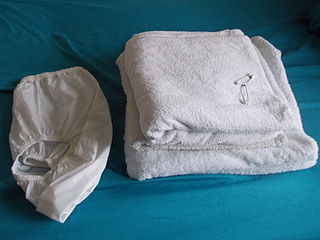
A cloth diaper or a cloth nappy or real nappy is a reusable diaper made from natural fibers, man-made materials, or a combination of both. They are often made from industrial cotton which may be bleached white or left the fiber’s natural color. Other natural fiber cloth materials include wool, bamboo, and unbleached hemp. Man-made materials such as an internal absorbent layer of microfiber toweling or an external waterproof layer of polyurethane laminate (PUL) may be used. Polyester fabrics microfleece or suedecloth are often used inside cloth diapers as a "stay-dry" wicking liner because of the non-absorbent properties of those synthetic fibers.

Cloth menstrual pads are cloth pads worn in the underwear to collect menstrual fluid. They are a type of reusable menstrual hygiene product, and are an alternative to disposable sanitary napkins or to menstrual cups. Because they can be reused, they are generally less expensive than disposable pads over time, and reduce the amount of waste produced.

Bunker gear is the personal protective equipment (PPE) used by firefighters. The term can refer, depending on the context, to just the trousers, boots and jacket, or to the entire combination of protective clothing. The terms are derived from the fact that the trousers and boots are traditionally kept by the firefighter's bunk at the fire station to be readily available for use.

Sportswear or activewear is clothing, including footwear, worn for sport or physical exercise. Sport-specific clothing is worn for most sports and physical exercise, for practical, comfort or safety reasons.
Layered clothing is a term describing a way of dressing using many garments that are worn on top of each other. Some of the layers have different, largely non-overlapping, functions. Using more or fewer layers, or replacing one layer but not others, allows for flexible clothing to match the needs of each situation. Two thin layers can be warmer yet lighter than one thick layer, because the air trapped between layers serves as thermal insulation. Layered clothing is particularly relevant in cold climates, where clothing must at the same time transfer moisture, provide warmth, and protect from wind and rain. In a hot and dry climate, clothes have very different functional requirements: they must block the radiation from the sun, and allow for sufficient air circulation. Therefore, layered clothing in the sense used in this article is largely irrelevant in hot and dry climates. The wicking layer moves the sweat from your skin, where it can be absorbed by the other layers.
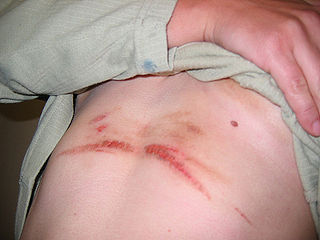
Chafing refers to the irritation of skin caused by repetitive friction, usually generated through skin to skin contact of multiple body parts. Chafing is usually contracted in the inner thighs and inner glutes; armpits and nipples can also develop chafing although it is less common. Severe chafing is known as friction burn.
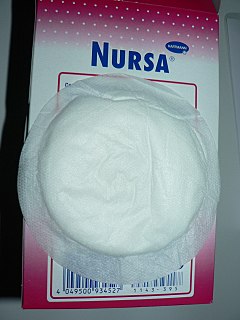
A nursing pad is a cloth or disposable pad worn against the nipple and breast of a nursing mother to absorb any milk that may leak between feedings. It is inserted between the bra and the breast. Disposable pads are common and located easily online or in specialty stores. Reusable cloth pads can be washed and used over. These may be less expensive. Changing the pad when it is wet will keep the nipple clean and dry.
Edna Murphey is the creator of the Odorono brand of deodorant and originator of modern-day deodorant marketing strategies (1912). Murphey's father, Dr. Abraham D. Murphey, a physician, developed the liquid antiperspirant to help surgeons with sweaty hands. Edna subsequently found this antiperspirant useful on underarms and began marketing the product to women. There had been other previous deodorant/antiperspirant inventions previous to Murphey's, however, Murphey's was the product that became widely distributed. Murphy called the deodorant, Odorono (Odor-o-no) and started the company Odorono Co. At the time, antiperspirant products were not widely used, and Murphey was, for the most part, unsuccessful at selling the product in the office she rented in Cincinnati. Many potential users thought the item was either unnecessary, potentially harmful to their health, or that the red color of the product would damage their clothing.
















